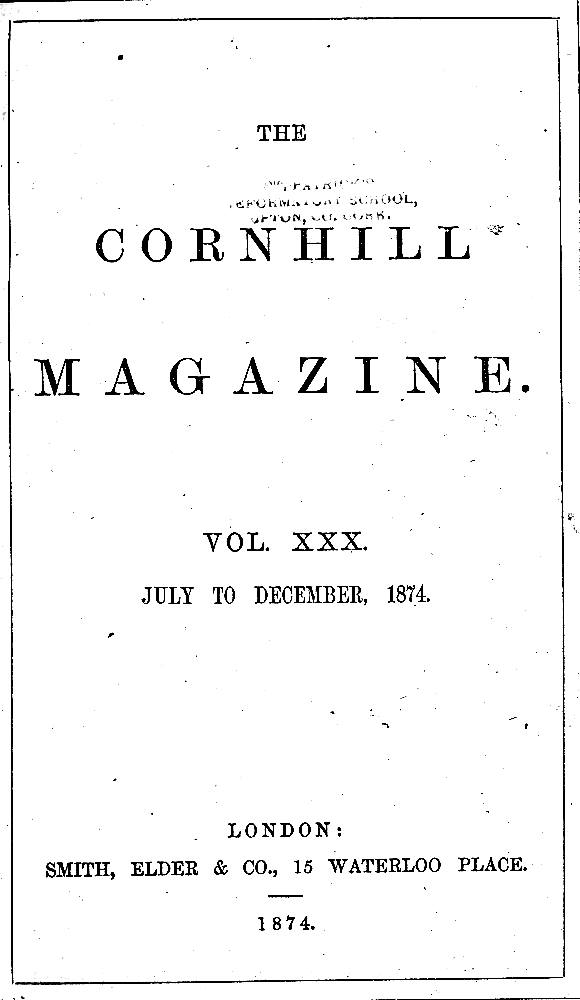
She opened a gate within which was a haystack in Chapters 39 ("Coming Home: A Cry") through 42 ("Joseph and His Burden: Buck's Head'.") in Vol. 30: pages 257 through 280 (24.5 pages in instalment); plates: initial "O" (5.8 cm wide by 7.5 cm high) signed "H. P." in lower-left corner, and She opened a gate within which was a haystack (facing page 257) vertically-mounted, 16.3 cm wide by 10.5 cm high, signed "H. Paterson" in the lower-right corner. The wood-engraver responsible for this illustration was Joseph Swain (1820-1909). [Click on the image to enlarge it; mouse over links.]



Above: The initial-letter vignette and first full page of the ninth instalment of the story: O (Vol. XXX).
Commentary: An Unusual Focal Character — Fanny Robin
In the September instalment of Far From the Madding Crowd in The Cornhill Magazine, Hardy establishes the significance of the workhouse as a symbol of personal and moral failure by Bathsheba's remarking in Chapter 30 that, under all the anxiety that Troy and Boldwood are putting her through, she expects to die "quite young" as a "friendless" pauper "in the Union" (p. 4) — that is, the Casterbridge Union Workhouse. This passage prepares us for the agonizing journey and death of Troy's belovéd, Fanny Robin, in the September instalment, which alerts us to her plight immediately through the main plate, which shows the little seamstress (readily distinguished from Bathsheba by her hair colour) slumped beneath a haystack and through the initial vignette. This latter drawing is a visual complement to Hardy's descriptions of the Casterbridge Workhouse at the close of Chapter 40, as Fanny, near death, arrives there, and at the beginning of Chapter 42, when Joseph Poorgrass appears driving Bathsheba's smartly painted wagon to collect Fanny's body for burial.
A connection that nineteenth-century serial readers probably made but which the subsequent volume readers are unlikely to have made is the pauper's fate (as signified by the opening plate and vignette) that may attend the woman whose husband is as addicted to racecourse betting as Frank Troy is. Indeed, the question of her husband's requisitions for ready cash has already become an irritant to the marriage as potent as Bathsheba's jealousy over the lock of blonde hair that Frank keeps in his watchcase. The September illustration is, in a sense, a direct result of August's, in which Frank has submerged his genuine feelings for Fanny in the sense of power that his relationship with the wealthy and malleable Bathsheba confers. Helen Paterson Allingham in womanly fellow feeling depicts in the June through September sequence the course of the twin romances of Frank Troy and their consequences, from Bathsheba's initial fascination with the Sergeant's sword-play through her anguish that she may be the cause of his suffering at a rival's hand and her seeking comfort in his masculine embrace while his first love, abandoned at the church on her wedding day, languishes in despair and poverty.
The details of clothing, so evident in other scenes with other characters, are absent here to good effect. Mrs. Allingham [sic] fills her engraving frame with haystack, wooden fences, farmyard, and tall tress as background, making the slumped, pathetic figure of Fanny seem like a bundle of discarded clothing. [Jackson 80]
Since the text establishes that "the penumbre" of an overcast night has rendered all about her indistinct owing to an absence of moon and stars, Paterson's clear delineation of objects at twilight is something of a cheat, but the highly textured backdrop reinforces the social isolation of the abandoned woman uncomforted in the illustration by the luminosity of distant Casterbridge, whose "weak, soft glow" dimly illuminates the scene and gives the solitary walker a sense of destination.
Throughout the 1874 sequence of twelve full-page illustrations and twelve initial-letter vignettes the artist tends to focus on Bathsheba and her lovers; moreover, seven full-page plates involve just two characters each, three depicting the principals in group contexts (February, May, and December). Thus, the full-page plate of Fanny Robin is unique in the series since it is a study of a lone individual, and, indeed, a relatively minor character, despite the long shadow she casts over Bathsheba's marriage to Frank Troy.
Scanned image and text by Philip V. Allingham. [You may use this image without prior permission for any scholarly or educational purpose as long as you (1) credit the person who scanned the image and (2) link your document to this URL in a web document or cite the Victorian Web in a print one.]
Bibliography
The Collected Letters of Thomas Hardy. Volume One: 1840-1892; Volume Three: 1903-1908, ed. Richard Little Purdy and Michael Millgate. Oxford: Clarendon, 1978, 1982.
Hardie, Martin. Water-colour Painting in Britain, Vol. 3: The Victorian Period, ed. Dudley Snelgrove, Jonathan Mayne, and Basil Taylor. London: B. T. Batsford, 1968.
Hardy, Thomas. Far From the Madding Crowd. With illustrations by Helen Paterson Allingham. The Cornhill Magazine. Vols. XXIX and XXX. Ed. Leslie Stephen. London: Smith, Elder, January through December, 1874.
Holme, Brian. The Kate Greenaway Book. Toronto: Macmillan Canada, 1976.
Jackson, Arlene M. Illustration and the Novels of Thomas Hardy. Totowa, NJ: Rowman and Littlefield, 1981.
Ray, Martin. "Victorian Map of Wessex." 23 Tues., Oct., 2001. (Hyperlink "mailto:en1090@abdn.ac.uk") en1090@abdn.ac.uk
Turner, Paul. The Life of Thomas Hardy: A Critical Biography. Oxford: Blackwell, 1998, 2001.
Created 14 October 2002 Last updated 30 October 2022